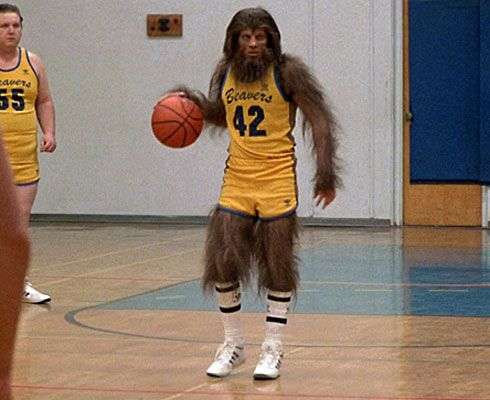Create a free profile to get unlimited access to exclusive videos, sweepstakes, and more!
Would wolves be good at basketball, or did Teen Wolf lie to us all?

You may be familiar with the famed fable suggesting that inside each of us are two wolves. For Scott Howard in the classic '80s film Teen Wolf, it was only one wolf, but it was a bit more literal.
In Teen Wolf, which turns 35 this month, Michael J. Fox plays Scott, a teenage nobody going through the worst bout of secondary puberty in pop-culture history. As he comes to terms with his lupine heritage, Scott learns some important lessons about friendship, romance, and being yourself — and he learns that being a werewolf comes with some pretty sweet basketball skills.
The school basketball team, the Beavers, haven’t had a win in years, but that all changes when Howard takes to the court with his new, furrier persona. Prior to this, his skill on the court is lackluster, to say the least, suggesting all of his newfound ability comes from his wolf side. Suddenly, he’s able to run faster, jump higher, and shoot better. This raises the obvious question, a question that has been tormenting moviegoers and evolutionary biologists for decades: Would a wolf be good at basketball?
SPEED
There are a number of abilities needed to succeed on the court. Wolves are undoubtedly good at some of them and not others, as we’ll discover together, but one thing they are absolutely good at is being fast.
While wolves typically lope at the more leisurely pace of five or six miles per hour, they are capable of achieving more than 35 miles per hour over short bursts (short bursts being up to a couple of kilometers). That equates to a little more than 51 feet per second, meaning a wolf could cover the 94 feet of a basketball court in less than two seconds. We’ve seen some incredibly skilled ballplayers in our time, but we’ve never seen that.
For context, Usain Bolt, the fastest human on Earth, clocked in at a top speed of 27.3 miles per hour or 40.04 feet per second, during his world record 100-meter sprint. Usain Bolt is fast, there’s no doubt about that, but even a middle-of-the-pack wolf (pun intended), is faster.
If ever you found yourself in a short distance race against a wolf, you’d be better off bowing out before the starting gun fires. Anything less than a 5k and you don’t stand a chance. The wolf will be long gone before you ever hit your stride.
That’s one in the can for the wolves. Should they decide to play team sports, they would absolutely annihilate us in the realm of pure speed. But what about...
ENDURANCE
Humans are notorious for having one of the best endurance quotients in the animal kingdom. Believe it or not, this is one area where ordinary humans win out.
Wolves are, to a certain degree, persistence hunters. They track their prey, following them at a slow jog, identifying weaknesses (old or sick animals), and waiting for the moment to strike. They succeed even in taking down prey faster than them by wearing them down.
But, no matter how successful wolves may be, when it comes to endurance, humans take the gold medal. This is due, primarily, to a series of adaptations that make us slow in the short term, but relatively fast over long distances.
Chief among these adaptations is our sweat glands. While other species rely on panting and rest to reduce heat, humans are able to cool off on the go. That means that, while we are slow, much like a certain battery-powered bunny, we just keep going. Over long enough distances, there is nothing faster on the earth than a human. We’ve succeeded over tens of thousands of years by being the Jason Vorhees of the animal kingdom; always walking, but always there. Given enough time other animals, wolves included, will run out of steam and collapse from exhaustion while we’re still trudging along, spear in hand.
But basketball courts and games aren’t all that long. So, while humans might have the edge if the game went into serious overtime, wolves would likely still beat us over the course of four quarters.
AIM
All the running and endurance in the world won’t win you a single game if you can’t get the ball through the hoop. That’s where aim comes in. And, once again, humans might just top the charts.
Research indicates that, at least when throwing objects as seen in team sports, humans are likely the best in the animal kingdom at this skill. Even when compared against our closest relatives (other primates), the accuracy of our throws is far and away more impressive than our non-human animal counterparts.
Accuracy is, of course, something which can be learned by practice, but even without that experience, humans are by default better at tossing than any other animals, wolves included. (Plus, it's not like a wolf could get a good grip on a basketball in the first place. Can't palm it with paws, obviously.)
Basketball is just a game, but games — both among humans and animals — are an important part of our development. They test skills and fitness, and even when they’re just for fun, they are a measure of our ability to survive in the world. Basketball showcases many of the abilities that have made us the most successful species on the planet, for better or for worse. Endurance, dexterity, average speed, and aim are the things that made us good hunters and allowed us to compete among other species that had bigger teeth and sharper claws.
So, sorry, Teen Wolf. While wolves are fast and have enough endurance to make it through four quarters of a basketball game, they don’t possess the requisite skills to best us in a game of hoops. Now, granted, we can’t speak to werewolves — maybe whatever magical confluence might have come about by mixing humans and canines would indeed translate to elite skill on the court — but whatever abilities Scott Howard brought to the game were likely more human than dog.
It seems, in the end, the real wolf was inside us all along.


























